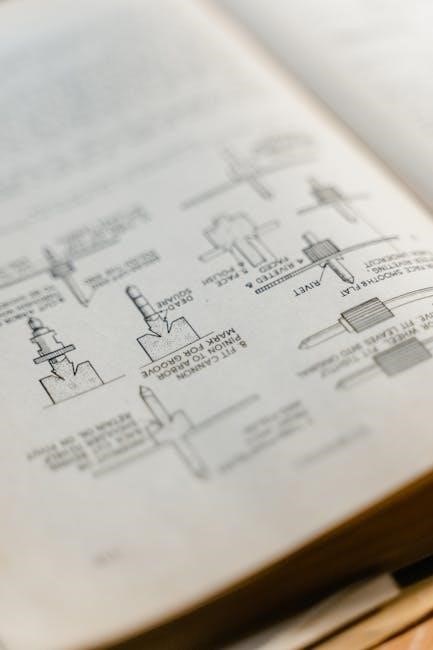The Illinois Technical Reference Manual is a crucial resource for engineering and construction, providing standardized procedures, material specifications, and design guidelines. It ensures compliance with state regulations, promoting safety and efficiency across projects.
1.1 Overview of the Manual
The Illinois Technical Reference Manual serves as a comprehensive guide for engineering, construction, and infrastructure projects. It outlines standardized procedures, material specifications, and design guidelines to ensure compliance with state and industry standards. The manual is widely used by professionals, including engineers, contractors, and planners, to ensure projects are executed safely and efficiently. It covers a broad range of technical areas, from transportation systems to environmental regulations, providing detailed frameworks for each. By adhering to the manual, stakeholders can maintain consistency, reduce risks, and meet legal requirements. Its structured approach makes it an indispensable tool for both public and private sector projects in Illinois.
1.2 Purpose and Scope
The Illinois Technical Reference Manual is designed to establish uniform engineering practices and ensure compliance with state and federal regulations. Its primary purpose is to provide clear technical guidance for designing, constructing, and maintaining infrastructure projects. The manual covers a wide scope, including transportation systems, environmental regulations, and material specifications. It serves as a central resource for engineers, contractors, and planners, promoting consistency and reducing project risks. By following the manual, professionals can ensure that their work aligns with industry standards and legal requirements, ultimately contributing to public safety and efficient project delivery across Illinois.
1.3 Structure and Organization
The Illinois Technical Reference Manual is meticulously organized to facilitate easy access to information. It is divided into clear sections, each addressing specific aspects of technical standards and practices. The manual begins with an introduction, followed by detailed sections on key features, applications, updates, case studies, digital tools, challenges, resources, and a conclusion. Each section is further subdivided into focused subsections, ensuring a logical flow of content. Features such as tables of contents, chapter divisions, and cross-references enhance navigation. This structured approach ensures that users can quickly locate relevant information, making the manual an indispensable resource for professionals in engineering and construction fields.

Key Features of the Illinois Technical Reference Manual
The manual provides comprehensive technical specifications, design criteria, and testing procedures, ensuring compliance with state regulations. It offers practical guidelines for engineering, construction, and infrastructure projects, prioritizing safety and efficiency.
2.1 Technical Specifications and Standards
The Illinois Technical Reference Manual outlines detailed technical specifications and standards for engineering and construction projects. These specifications ensure materials and construction methods meet state and federal regulations. Key areas include material quality, testing protocols, and design tolerances. The manual references industry standards like ASTM and AASHTO for consistency. It also provides guidelines for safety, environmental compliance, and best practices in infrastructure development. By adhering to these specifications, professionals can ensure projects are durable, sustainable, and meet public safety expectations. The manual is regularly updated to reflect advances in technology and evolving regulatory requirements, making it a reliable resource for engineers and contractors.
2.2 Design Criteria and Guidelines
The Illinois Technical Reference Manual provides comprehensive design criteria and guidelines to ensure projects meet engineering best practices. It covers structural integrity, load calculations, and material compatibility, emphasizing safety and durability. The manual includes environmental considerations, such as stormwater management and energy efficiency. Guidelines are supported by case studies and practical examples, offering real-world applications. The document also addresses cost-effectiveness and long-term maintenance, helping professionals balance project goals with budget constraints. Regular updates ensure the manual reflects the latest engineering advancements and regulatory changes, making it an indispensable tool for designing compliant and sustainable infrastructure projects across Illinois.
2.3 Material Requirements and Testing Procedures
The Illinois Technical Reference Manual outlines specific material requirements to ensure quality and durability in construction projects. It specifies acceptable materials, such as concrete, steel, and aggregates, and their adherence to state and industry standards. The manual also details rigorous testing procedures, including laboratory and field tests, to verify material properties. These procedures include compressive strength tests for concrete, tensile strength tests for steel, and gradation analysis for aggregates. Documentation and certification processes are emphasized to maintain compliance. Non-compliant materials are addressed with corrective actions to ensure project integrity. These guidelines aim to uphold safety, durability, and regulatory compliance in all infrastructure developments.

Application of the Manual in Various Fields
The Illinois Technical Reference Manual is widely applied in transportation, infrastructure, and environmental projects, ensuring adherence to standardized practices and promoting safety, efficiency, and sustainability across diverse sectors.
3.1 Transportation and Infrastructure Projects
The Illinois Technical Reference Manual plays a pivotal role in shaping transportation and infrastructure projects across the state. It provides detailed guidelines for designing roadways, bridges, and public transit systems, ensuring adherence to safety and durability standards. Engineers and planners rely on the manual to select appropriate materials, conduct site analyses, and implement sustainable practices. Its specifications are crucial for maintaining compliance with federal and state regulations, particularly in high-stakes environments like highway construction. By offering standardized protocols, the manual streamlines project execution, reduces costs, and enhances the longevity of infrastructure. It serves as a cornerstone for modernizing Illinois’ transportation network while addressing environmental concerns and promoting public safety.
3.2 Construction and Building Codes
The Illinois Technical Reference Manual is instrumental in enforcing and streamlining construction and building codes across the state. It provides comprehensive guidelines for adhering to safety standards, structural integrity, and environmental regulations. Architects, contractors, and engineers rely on the manual to ensure compliance with local and national building codes. The document outlines specific requirements for materials, inspections, and certifications, ensuring that all construction projects meet rigorous quality benchmarks. By standardizing practices, the manual reduces discrepancies and potential risks, fostering a safer and more efficient construction environment. Regular updates to the manual reflect evolving industry standards, making it a vital resource for compliance and best practices.
3.3 Environmental and Safety Regulations
The Illinois Technical Reference Manual plays a pivotal role in ensuring adherence to environmental and safety regulations. It provides detailed guidelines for managing waste, controlling emissions, and mitigating hazards in construction and infrastructure projects. The manual aligns with both state and federal environmental standards, offering best practices for sustainable practices and risk reduction. By incorporating safety protocols and environmental compliance, it helps organizations avoid legal penalties and promote public well-being. Regular updates ensure the manual reflects the latest regulatory changes, making it an essential resource for maintaining ecological balance and workplace safety. Its comprehensive approach supports Illinois’ commitment to environmental stewardship and safety excellence.

Updates and Amendments to the Manual
The Illinois Technical Reference Manual undergoes regular updates to reflect advancements in technology, regulatory changes, and user feedback, ensuring it remains a relevant and authoritative resource.
4.1 Frequency of Revisions
The Illinois Technical Reference Manual is updated periodically to reflect advancements in technology, changes in regulations, and emerging industry standards; Revisions are typically annual, ensuring the manual remains aligned with current practices and requirements. Unscheduled updates may occur to address critical issues or new developments. The revision process involves stakeholder input, including feedback from engineers, contractors, and regulatory bodies, to ensure the updates are comprehensive and practical. This regular maintenance ensures the manual stays relevant and continues to serve as a trusted resource for professionals in Illinois. Users are encouraged to check for the latest version to stay compliant with updated guidelines.
4.2 Process for Updating Technical Content
The Illinois Technical Reference Manual undergoes a structured update process to ensure accuracy and relevance. Revisions begin with an initiation phase, where stakeholders identify necessary changes based on feedback, new technologies, or regulatory updates. A drafting team, comprising experts in relevant fields, prepares revised content. The updated material is then reviewed by technical committees and undergoes public comment periods to incorporate external insights. Following approval, the revised content is published in a new edition or supplement. The process emphasizes collaboration, transparency, and thorough validation to maintain the manual’s authority and reliability as a key technical resource in Illinois.
4.3 Importance of Staying Current
Staying current with the Illinois Technical Reference Manual is essential for ensuring compliance with evolving standards and regulations. Regular updates reflect advancements in technology, safety protocols, and environmental requirements, directly impacting project execution and compliance. Failing to stay current can lead to non-compliance, safety risks, and inefficiencies. Professionals relying on outdated information may face legal consequences or project delays. By staying informed, users access the latest best practices, ensuring their work remains efficient, safe, and aligned with regulatory expectations. The manual serves as a cornerstone for reliable and up-to-date technical guidance, making regular updates indispensable for all stakeholders involved in Illinois projects.

Case Studies and Practical Examples
This section provides real-world applications of the manual, showcasing successful projects and challenges faced. Practical examples highlight effective implementation strategies, offering insights and best practices for users.
5.1 Successful Implementation in Projects
The Illinois Technical Reference Manual has been instrumental in ensuring compliance and efficiency across various infrastructure projects. By adhering to the manual’s guidelines, engineers and contractors have successfully implemented standardized procedures, resulting in safer and more durable structures. For instance, transportation projects have benefited from precise material specifications and design criteria, while green infrastructure initiatives have utilized the manual’s environmental regulations to minimize ecological impact. These successes demonstrate the manual’s role in fostering innovation and best practices, ensuring that projects meet both state and federal standards while addressing real-world challenges effectively. Practical examples highlight the importance of proper implementation strategies.
5.2 Lessons Learned from Real-World Applications
Real-world applications of the Illinois Technical Reference Manual have revealed valuable insights into its effectiveness. Projects that adhered strictly to the manual’s guidelines experienced fewer delays and higher compliance rates. For instance, transportation infrastructure projects highlighted the importance of precise material specifications to ensure durability. Additionally, environmental initiatives, such as wastewater recycling, demonstrated how the manual’s safety and regulatory standards could balance innovation with ecological preservation. Lessons learned emphasize the need for thorough adherence to design criteria and regular updates to address emerging challenges. These practical applications underscore the manual’s adaptability and its role in mitigating risks while promoting sustainable practices across industries.
5.3 Best Practices for Users
Best practices for using the Illinois Technical Reference Manual involve understanding its structure and staying updated on revisions. Users should familiarize themselves with the manual’s organization to quickly locate relevant sections. Regularly reviewing updates ensures compliance with the latest standards. Leveraging digital tools, such as search features and integration with other resources, enhances efficiency. Training programs and workshops can deepen understanding and application. Collaborating with experts and engaging in community forums fosters shared knowledge and problem-solving. By adhering to these practices, users can maximize the manual’s benefits, ensuring projects meet regulatory and technical requirements while maintaining safety and innovation.

Digital Accessibility and Tools
The Illinois Technical Reference Manual is accessible via digital platforms, offering robust search features and integration with complementary tools, enhancing navigation and accessibility for engineers and professionals.

6.1 Online Platforms for Accessing the Manual
6.2 Search and Navigation Features
The Illinois Technical Reference Manual incorporates advanced search and navigation features to enhance user experience. Users can employ Boolean operators, phrase searching, and keyword filters to quickly locate specific content. The manual’s digital version includes a robust search bar that highlights relevant sections, while hyperlinked tables of contents enable easy navigation. Additionally, bookmarks and page thumbnails allow users to save frequently accessed pages. These features ensure that professionals can efficiently find and reference critical information, streamlining their workflow and improving productivity. The intuitive design of the manual’s search and navigation tools makes it a user-friendly resource for engineering and construction projects.
6.3 Integration with Other Technical Resources
The Illinois Technical Reference Manual seamlessly integrates with other technical resources, ensuring comprehensive support for engineers and professionals. It cross-references state and federal guidelines, aligning with industry standards and complementary tools. Users can access linked documents, such as CAD standards and material specifications, directly from the manual. This integration enhances workflow efficiency by providing a centralized hub for technical information. Regular updates ensure compatibility with evolving technologies and regulatory requirements. By bridging gaps between diverse technical resources, the manual serves as a cohesive framework for interdisciplinary projects, fostering collaboration and consistency across industries. This holistic approach makes it an indispensable resource for modern engineering practices.

Challenges and Limitations
The Illinois Technical Reference Manual faces challenges like misinterpretation of guidelines, technical limitations in niche areas, and the need for continuous user feedback to address evolving industry demands.
7.1 Common Misinterpretations of Guidelines
The Illinois Technical Reference Manual sometimes faces issues with users misinterpreting its guidelines due to vague language or overly technical terminology. This can lead to incorrect applications in projects, potentially causing safety or compliance risks. Additionally, the complexity of certain sections may result in varied interpretations among professionals, especially those with limited expertise. To address this, the manual emphasizes the importance of proper training and adherence to updated standards. Regular updates and clarifications are also provided to reduce ambiguity. Users are encouraged to consult supplementary resources and expert networks for clearer understanding and practical application of the guidelines.
7.2 Limitations in Specific Technical Areas
The Illinois Technical Reference Manual may have limitations in addressing highly specialized or emerging technologies due to its broad scope. Certain technical areas, such as advanced material science or innovative construction methods, may not be covered in depth. This can result in reliance on supplementary resources for cutting-edge applications. Additionally, the manual’s focus on state-specific regulations may limit its applicability to projects outside Illinois. Despite these limitations, it remains a foundational resource, providing essential guidelines while encouraging users to consult additional specialized documents for complex or region-specific requirements. Regular updates aim to address these gaps, ensuring relevance and adaptability in evolving technical fields.
7.3 User Feedback and Suggestions for Improvement
Users of the Illinois Technical Reference Manual have provided feedback highlighting its clarity and accessibility. Many appreciate its structured approach but suggest enhancements in certain areas. Some recommend adding more visual aids, such as diagrams and flowcharts, to simplify complex technical concepts. Others propose expanding the manual’s coverage of emerging technologies and sustainable practices. Additionally, users have requested more interactive features, like advanced search capabilities and cross-referencing tools, to improve navigation. These suggestions aim to enhance usability and ensure the manual remains a comprehensive and indispensable resource for professionals in engineering, construction, and related fields. Regular updates incorporating such feedback are essential for its continued relevance.

Resources for Further Learning
The Illinois Technical Reference Manual offers supplementary materials, training programs, and online resources to enhance understanding and application of its guidelines, ensuring users stay informed and up-to-date.
8.1 Training Programs and Workshops
The Illinois Technical Reference Manual is supported by comprehensive training programs and workshops designed to enhance user understanding and application of its guidelines. These programs cover technical specifications, design criteria, and material requirements, ensuring professionals are well-equipped to implement the manual’s standards effectively. Workshops often include hands-on exercises and real-world case studies, fostering practical skills and problem-solving abilities. Additionally, these sessions provide opportunities for networking and collaboration among industry experts. Regular updates to the training content ensure alignment with the latest revisions of the manual, making these resources indispensable for staying current and proficient in its use.
8.2 Supplementary Technical Documents
Supplementary technical documents complement the Illinois Technical Reference Manual by providing in-depth information on specific topics, ensuring comprehensive understanding and application. These documents include detailed datasheets, case studies, and technical bulletins that expand on key sections of the manual. They are designed to address complex technical areas, offering practical insights and examples. Regularly updated to reflect the latest industry standards, these resources are essential for professionals seeking advanced knowledge. They are accessible through official channels, ensuring users have access to reliable and current information to support their work with the manual effectively.
8.4 Community Forums and Expert Networks
Community forums and expert networks serve as vital platforms for discussing the Illinois Technical Reference Manual, fostering collaboration among professionals. These forums enable users to share experiences, resolve challenges, and gain insights from industry experts. Participants can engage in discussions about best practices, troubleshooting, and interpretations of the manual’s guidelines. Experts often provide clarity on complex technical aspects, ensuring proper implementation. Additionally, these networks facilitate access to resources, updates, and real-world applications of the manual. By leveraging collective knowledge, users can enhance their understanding and application of the manual, staying informed about the latest developments and standards in their field.
The Illinois Technical Reference Manual is an essential resource for engineers and professionals, ensuring compliance with standards and promoting innovation in technical projects across the state.
9.1 Summary of Key Points
The Illinois Technical Reference Manual serves as a comprehensive guide for engineers, contractors, and professionals, outlining standardized procedures, design criteria, and material specifications. It ensures compliance with state regulations, promoting safety and efficiency in transportation, construction, and environmental projects. Regular updates reflect advancements in technology and industry standards. The manual’s structured approach facilitates practical application across various fields, making it an indispensable resource for ensuring project integrity and adherence to best practices. Its digital accessibility and integration with technical tools further enhance its utility, supporting professionals in staying current with evolving technical demands and delivering high-quality outcomes consistently.

9.2 Future Directions for the Manual
The Illinois Technical Reference Manual is expected to evolve with advancements in technology and industry standards. Future updates will likely include expanded sections on sustainable practices, digital integration, and emerging construction materials. Enhancing accessibility through interactive digital tools and real-time updates will remain a priority. The manual may also incorporate feedback from users to address specific challenges and improve clarity. Additionally, it could expand into new areas such as renewable energy and smart infrastructure, aligning with global trends. Continuous collaboration with experts and stakeholders will ensure the manual remains a leading resource for professionals, fostering innovation and excellence in technical applications across Illinois.
9.3 Final Thoughts on Its Importance
The Illinois Technical Reference Manual is a cornerstone for professionals in engineering, construction, and related fields, ensuring projects meet rigorous standards. Its comprehensive guidance fosters innovation, safety, and compliance, making it indispensable for modern technical applications. By providing clear, standardized procedures, it supports efficient project execution and reduces uncertainties. The manual’s importance extends to training and professional development, equipping users with essential knowledge. Its adaptability to future challenges and technological advancements ensures its continued relevance. Ultimately, the manual plays a vital role in maintaining Illinois’s infrastructure integrity and promoting sustainable development, solidifying its value as a trusted, evolving resource for years to come.





